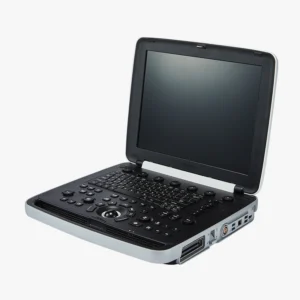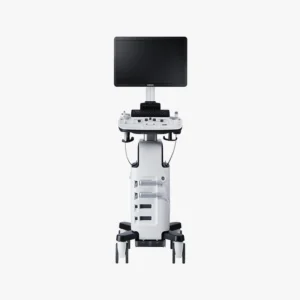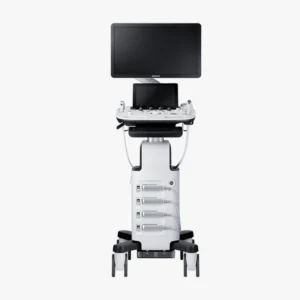
por Luis Daniel Fernádez | Dec 18, 2024 | Equipment analysis
Ultrasoundultrasonography, also known as ultrasonography, is a non-invasive technique using ultrasound to obtain real-time images of the inside of the body. For this purpose, a medical equipment specific: the ultrasound scannerHow does it work and what types of ultrasound scanners are available on the market? We address this in the following article.
The ultrasound scanner: How does it work?
The ultrasound scanner is a medical equipment in the field of image diagnosis. It employs a device called a transducer which emits high-frequency sound waves, called ultrasound. These waves are inaudible to the human ear and travel through the different internal tissues of the body. At the moment when the waves encounter the various organs and structures, it is when are reflected as echoes. These echoes are picked up by the transducer and generate the medical images that can be displayed on a screen. These images are known as ultrasound scans and allow professionals to evaluate different tissues and internal organs of the organism.
In the realization of a ultrasoundis used, a transducer that glides over the skin in the area to be analyzed. This device is coated with a conductive gel that facilitates the transmission of ultrasound waves. It has the function of eliminating the air that exists between the skin and the transducer, helping to improve the quality of the images. In an ultrasound scan, the following can be obtained still images and also allows to observe the movement in real time. It is an essential medical equipment in medicine that has the function of analyzing the state of organs such as the heart or blood flow.
Meet our 4D Medical equipment
Parts of an ultrasound scanner
An ultrasound scanner consists of the following components:
| Parts of an ultrasound scanner |
Description |
| Transducer or probe |
Device in charge of emitting and receiving ultrasonic waves. |
| Monitor |
Screen where the images generated by the ultrasound scanner are displayed. |
| Control panel |
Interface with buttons and controls to adjust parameters and settings. |
| Central processing unit |
Processor that handles the data and generates the ultrasonic images. |
| Storage system |
Allows to save images and data obtained during diagnosis. |
| Power supply |
Provides electrical power to the device. |
| Software |
Program that controls the operation of the ultrasound scanner and processes the images. |
| Handles and wheels |
Facilitate the mobility of the equipment within the hospital or clinic. |
| Ports and connections |
They allow the connection of accessories and additional devices. |

Detailed image of the parts of an ultrasound scanner
Transducer or probe
It is the main part of the device, responsible for transforming electrical signals into ultrasound waves. They are made of piezoelectric material and function as ultrasound emitters and receivers. There are different types of transducers:
Depending on its use
- LinearThey are used for superficial and vascular studies. They generate rectangular images and use high frequencies, since they do not require much penetration, being useful in the exploration of ligaments, tendons, muscles, thyroid, scrotum, breast and superficial vessels.
- Curved or convexThey have a curved shape and produce trapezoidal images. They are used with low frequencies because they are designed to explore deep structures, as in obstetrics and abdominal studies in general.
- Endocavitary or intracavitaryThey can be linear or convex. Their frequency varies according to the required penetration. They are used in intravaginal and intrarectal studies, for gynecological or prostate examinations.
- SectorialThey are a variant of the convex transducers and offer triangular or fan-shaped images. They use frequencies similar to those of curved transducers and allow an intercostal approach, so they are used in cardiac and abdominal studies.
According to frequency
- High frequency (up to 15 MHz)They are used to explore small and superficial structures.
- Low frequency (approximately 2.5 MHz)They are used for ultrasound scans that require a greater depth of penetration.
Monitor
Displays the images generated by the processing unit.The image is displayed on the monitor, so that professionals can observe and evaluate the state of the different anatomical structures in real time. Most current monitors can reproduce images in grayscale and color.
Control panel
It is located in the front part of the ultrasound scanner and allows the ultrasound specialist to make various adjustments to the equipment configuration. It allows to modify the brightness, the sharpness of the images and the frequency of the sound waves. In addition, it also allows to configure the necessary parameters to carry out the type of ultrasound that the patient requires.
Central processing unit
It is the component that receives the information provided by the probe. It converts the signals into electrical impulses and generates the image of the anatomical part of the area to be analyzed.
Storage system
It is the internal element that allows to save images and patient's data for further analysis. It can consist of an internal memory, USB or be connected to a PACS system (Picture Archiving and Communication System).
Power supply
Provides power to the ultrasound machineThe power supply is provided either by alternating current or by rechargeable batteries in the portable models.
Software
It is essential for processing ultrasound signals and generating medical images. It can include specific modules for different types of studies, such as cardiology or gynecology, among other areas.
Handles and wheels
These elements facilitate handling and transport of the equipmentespecially in the case of mobile ultrasound scanners.
Ports and connections
This type of components included in the ultrasound scanners are used for connect multiple probes, USB devices or DICOM interfaces to share images.
Types of ultrasound scanners
Having analyzed the operation of an ultrasound scanner and its main components, we can differentiate between different types of ultrasound scanners:

Imaging technology
1. 2D ultrasound scanners
- These are the most common and basic models. Generan two-dimensional images in real timeThey are widely used in the obstetrics area, to perform general and abdominal studies.
- Main applicationsBasic analysis, pregnancy control and organ evaluation.
2. 3D ultrasound scanners
- Allow display three-dimensional structures in real timeproviding greater detail. They are useful for creating more accurate images of fetuses and studying structural abnormalities.
- Main applicationsThey are used in advanced obstetrics and for surface studies of organs and tumors.
3. 4D ultrasound scanners
- They add the time dimension to 3D imagesallowing to see the movement in real time. It is especially useful in the obstetrics area to see fetal movements.
- Main applicationsObstetrical diagnosis and dynamic studies of joints.
4. Doppler ultrasound scanners
- They use the Doppler effect for assessing blood flow in vessels and organs. There are different models and variants:
- Color DopplerThey offer a color representation of the blood flow.
- Pulsed Doppler technologyThey provide a more detailed analysis of blood flow velocities.
- Continuous DopplerThey measure very fast flows.
- Main applicationsThey are used for vascular, cardiac and circulatory studies.
5. Tissue Doppler Ultrasound Scanners
- They are in charge of making a specific evaluation of the movements of the heart tissues and blood flow.
Mobility
1. Portable ultrasound scanners
- They are small and lightweight devicesThey are ideal for home transport, emergency or remote areas. There are multiple versions that include advanced technologies, such as 2D ultrasound, Doppler, etc.
- Main applicationsThey are used for emergencies and ICU, mobile clinics and medical visits to remote areas.
2. Trolley or console ultrasound scanners
- They are larger and more robust models. They have a fixed console that offers a variety of functions and high-resolution imaging options.
- Main applicationsThey are used in hospitals and specialized clinics.
3. Wireless ultrasound scanners
- They are connected to mobile devicesThe medical imaging systems, such as tablets or smartphones, through applications. They are characterized by high portability and immediate access to the generated medical images.
- Main applicationsThey are used in sports medicine, emergencies and telemedicine.
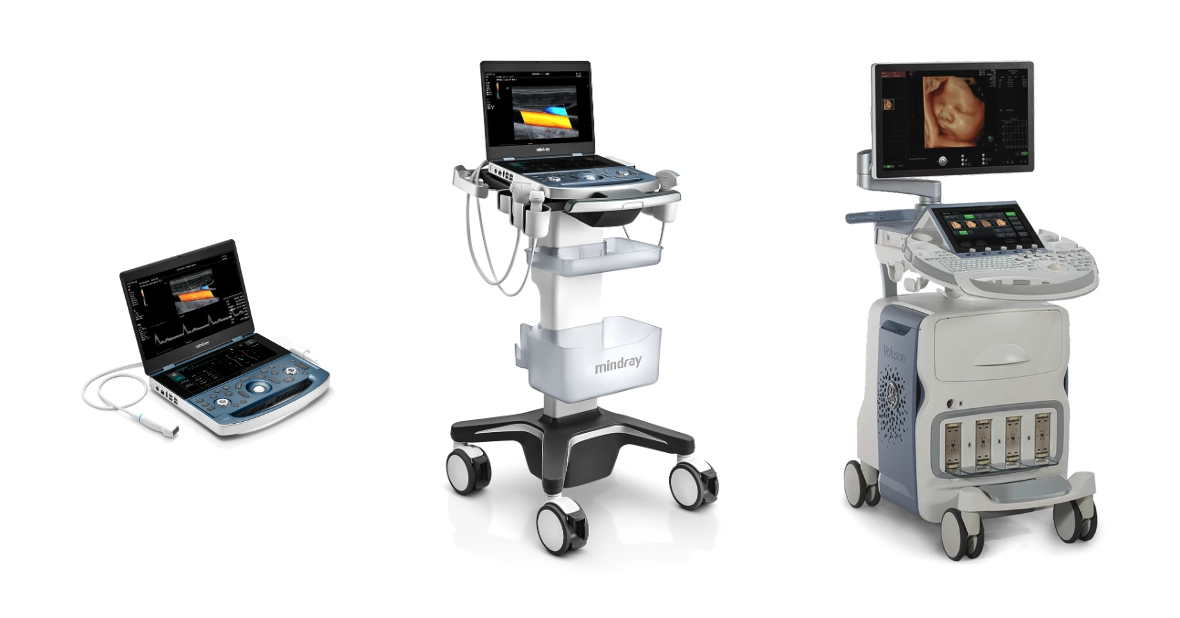
Clinical Specialty
1. Obstetrics and gynecology
- This type of transvaginal ultrasound scanners are specialized in the visualization of the fetus, uterus and ovaries of women.
2. Cardiac (Echocardiograms)
- They are designed to evaluate the structure and heart function, valves and blood flow.
Vascular
- They are used for analize arteries and veinsmeasuring the flow and detecting obstructions or thrombi.
4. Musculoskeletal and Physical Therapy
- Allow visualizing muscles, ligaments, tendons and joints. These physiotherapy ultrasound scanners are used in sports medicine to detect injuries or to analyze the recovery from an injury.
5. Abdominals
- They are oriented to the study of abdominal organs like the liver, kidneys, spleen or pancreas.
6. Neurological
- They are used for assessing the brainespecially in neonates.
7. Urological
- These devices are designed to examine the kidneys, bladder and prostate of the male.
8. Endoscopic
- They combine ultrasound with endoscopes to obtain internal images of the digestive tract or areas of difficult access.
Resolution and advanced technology
1. High resolution
- This type of medical equipment offers images of the highest qualityIt is therefore especially useful in complex applications.
2. Ultrasound scanners with Artificial Intelligence (AI)
Type of purchase
1. New ultrasound scanners
New ultrasound scanners are newly manufactured, previously unused ultrasound machines with the latest technology upgrades and full manufacturer's warranties. They feature the following characteristics:
- State-of-the-art technologyThey incorporate the latest innovations in imaging, such as advanced Doppler, elastography, 3D and 4D ultrasound and even artificial intelligence.
- Full warrantyThey offer extensive warranties that are backed by the manufacturer, generally from 1 to 5 years.
- CustomizationYou have the possibility to configure the equipment according to your specific needs, including transducers and software.
- Longer service lifeSince they have no previous use, their potential useful life is longer, especially if proper maintenance is carried out.
- Certifications and technical supportThey comply with all current quality and medical safety standards. In addition, they have specialized technical support.
2. Second-hand or opportunity ultrasound scanners
The used ultrasound scanners are previously used ultrasound devices that have been reconditioned or overhauled to ensure their functionality before being sold again. These devices may come from clinics, hospitals or doctors' offices that have refurbished them for newer models or no longer need them. Compared to new models, they have the following features characteristics:
- Technical reviewBefore being sold, ultrasound scanners undergo a series of quality tests to ensure that they are functioning properly. These may include repairs, cleaning, calibration and software upgrades.
- Reduced priceThey are less expensive than new equipment, which makes them attractive for small clinics, independent physicians or institutions with limited budgets.
- Variety of modelsYou can find from basic ultrasound scanners to advanced equipment with technologies such as Doppler or 3D.
- Limited WarrantySome suppliers offer warranties, but these are usually shorter than those for new equipment.
- Variable statusThe performance and service life of used ultrasound scanners will depend on how well the device has been maintained during previous use.
Conclusion
The ultrasound scanner es un equipamiento médico que tiene un gran uso en el campo del diagnóstico por imagen para realizar una de las pruebas médicas más populares: la ecografía. En función de la tecnología, la movilidad, la especialidad médica y el tipo de compra, se pueden encontrar diferentes tipos de ecógrafos.
There is a wide range of ultrasound scanners on the market that adapt to each of the medical needs. If you need more information, contact us and from 4D Médica we will offer you personalized advice so that you can choose the most suitable ultrasound scanner for your center.
Contact 4D
Luis Daniel Fernandez Perez
Director of Diagximag. Distributor of medical imaging equipment and solutions.
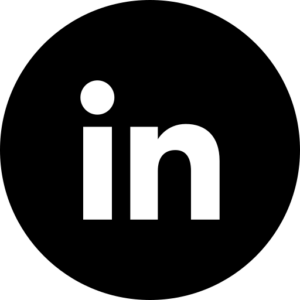

por Luis Daniel Fernádez | Dec 13, 2024 | Equipment analysis
The technology has had a significant impact on the healthcare system, especially in the radiology area. In recent years, one of the most relevant changes following the advent of the Internet has been the use of computerized systems in the field of image diagnosis. This has allowed the development of a digital imaging department where medical information can be managed and stored conveniently and securely.
In a digital imaging department, we can distinguish three fundamental tools: the PACS system, the RIS system and the HIS system. In the following article, we analyze what the PACS system is, how it works and its relationship with the RIS and HIS system.
What is the PACS system in radiology?
The term PACS stands for Picture Archiving and Communication System, which refers to Image Archiving and Communication System. This is a computer software used in the radiology area for the following purposes store, manage, present and share medical images and diagnostic procedure reports electronically.
Before the advent of the PACS system in radiology, the images generated after diagnostic examinations were stored in a physical format, mainly as radiographic films. Therefore, from the time the medical test was performed, there was a long process until the final image was obtained. With digitization, it is now possible to resort to a AI software for the different medical teams to obtain an accurate faster and more efficient access to informationwhich will allow optimize workflow in clinical practice.
How does the PACS system work?
A PACS system consists of a series of mechanical and electronic components which are connected to each other by a copper or fiber optic communication network. Specifically, we can differentiate between four main components:
- Image acquisition hardware
- Workstations for image interpretation and review
- Servers for storage and transmission of images
- Network for data transmission
All these elements work in an integrated manner to allow medical images to be captured, stored, distributed and displayed digitally. Through the use of this network, the graphic information generated in different studies, such as a CT scan, is transmitted to the magnetic resonance imaging o TAC.
How does this process unfold?
First of all, data from the system servers is passed to the archiving drives. Subsequently, they are distributed to the stations where radiological physicians review the generated medical images and also to the teleradiology serverswhich allow access to the archive through the Internet.
With a digital radiology PACS system, you can view images remotely from any medical department, office or externally. To do so, health care personnel have special identification codes which allows them to access diagnostic tests for each patient.
The DICOM medical imaging communication standard
For information and images to flow through the PACS system components, it is necessary to comply with the DICOM medical image communication standard. DICOM stands for Digital Imaging and Communications in Medicine and is a standard for the communication of medical images. standard for digital storage and transmission of medical images and related patient information.
It is responsible for define the file format and structure and, in turn, includes a communications protocol to facilitate connectivity between medical devices and systems. However, it should be noted that the majority of modern devices and medical equipment current DICOM images are produced.
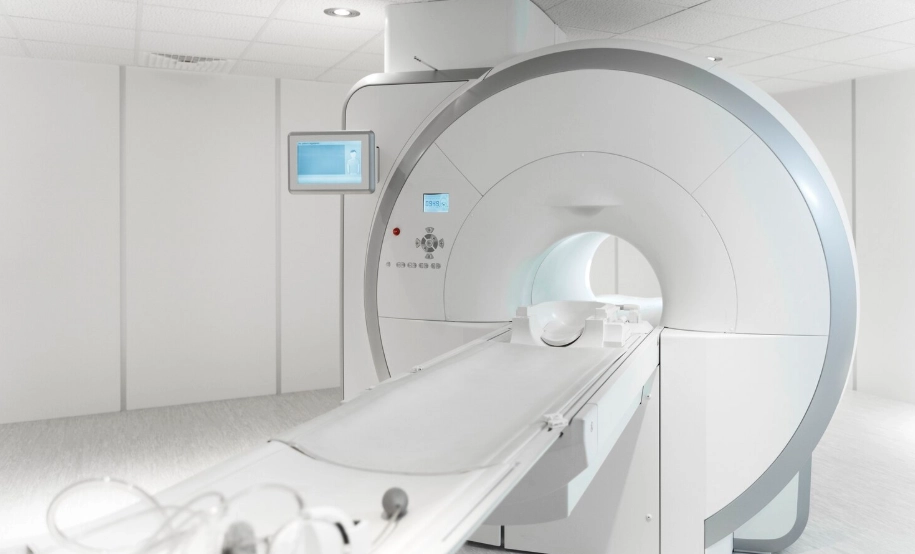
Advantages of using a PACS system in radiology
We analyze the main advantages offered by a PACS system in the management of radiological images:
Improved workflow in radiology departments
Radiologists and medical teams involved in the diagnostic imaging process can access and review digital images from any workstation on the hospital's network or remotely through the web server. This allows rapid consultation of studies and collaboration between physicians and specialists.
Error reduction
As the format of medical images is no longer physical, eliminating the possibility of duplicate diagnoses and also reduces both the risk of loss as the damage of the generated medical images.
Integration with other IT systems
One of the main advantages of the PACS system is that it allows the integration with other IT systems that can be used in health careThe RIS (Radiological Information System) and HIS (Hospital Management Software).
Capacity to store large volumes of data
Not only is it essential for clinical management and patient care, being able to store large volumes of medical imaging data is a key aspect for research and education in the area of health and medicine. In this way, researchers can access image databases for studies and students in training can use many of the images as educational material.
More accurate and detailed diagnosis
The use of the PACS system provides a more detailed reading of the diagnoses. This is mainly because the images are reviewed on high-resolution monitors and can be manipulated more accurately, which helps to detect abnormalities present in the image more quickly and accurately.
Saving time and resources
Another of its advantages is that it offers a time saving and a decrease in the workload of the staff.The cost of printing X-rays and other radiological elements was also reduced. At the same time, waiting times and resources at the hospital level are reduced.
Relationship between the PACS, RIS and HIS system
PACS, RIS and HIS are three systems key components in the digital health informatics ecosystem. Their interrelation is essential for the efficient functioning of the healthcare services of any clinic, health center or hospital. While the PACS system in radiology is used to manage, store and share images of the different diagnostic imaging procedures, the RIS and HIS system have other functions. What is each used for and what is the relationship between them?
The RIS system
The RIS system or Radiology Information System, is the program that runs the digital radiology department. It is a software that contains all the information of the radiology area and hospitals, thus enabling manage information and processes related to diagnostic imaging services.
Functions performed
- Scheduling of appointments and studies
- Order generation
- Recording of results with the generated medical images
- Workflow management in the radiology department
The HIS system
As for the Hospital Information System (HIS), it is a system of hospital information system. By using it, all the data are stored in the data related to the management and administration of a hospital. It is designed to manage all areas involved in the operation of a hospital from a single platform.
Functions performed
- Management and scheduling of medical appointments
- Patient care: Administration of patients' medical records and results of medical examinations performed.
- Human Resources
- Billing
- Monitoring the quality of medical care
Interaction of PACS, RIS and HIS systems
- HISThe central system that coordinates and stores all patient information in a clinic or hospital facility, including demographic, clinical and financial data.
- RISIt communicates with the HIS system to obtain relevant patient information and to manage the radiology area. It is used to schedule radiological procedures requested from other areas of the hospital.
- PACSRIS-PAC: Works hand in hand with RIS to store and manage the medical images generated by the requested studies. The RIS-PAC interaction allows the report to be presented in both systems so that each report appears linked to the images of the study performed.
Conclusion
The PACS system is a fundamental tool in the radiology area to be able to store and manage medical images digitally. All of this helps to improve healthcare and drive faster, more detailed and accurate clinical diagnosis.
If you need more information about our imaging solutions, just contact us and our staff will give you personalized advice.
Contact
BIbliography
Clínica Universidad de Navarra (n. d.). PACS. Medical dictionary. Retrieved from
https://www.cun.es/diccionario-medico/terminos/pacs
Ochoa, P. J., Murillo, M. R., & Torres, J. A. (2004). PACS system (picture archiving and transmission system). Anales de Radiología de México, 3(3), 153-162. https://www.analesderadiologiamexico.com/previos/ARM%202004%20Vol.%203/ARM_04_3_3_Julio-Septiembre/arm_04_3_3_153-162.pdf
López-Arroyo, A., Villarreal-García, A. J., & López-Arroyo, S. (2005). The DICOM format and PACS systems in medical imaging. Gaceta Médica de México, 141(5), 477-485. Retrieved from https://www.scielo.org.mx/pdf/gmm/v141n5/v141n5a11.pdf
Clinic Cloud (n. d.). DICOM format: what it is and how this standard works in medical imaging. Retrieved from https://clinic-cloud.com/blog/formato-dicom-que-es-estandar-imagenes-medicas
Luis Daniel Fernandez Perez
Director of Diagximag. Distributor of medical imaging equipment and solutions.

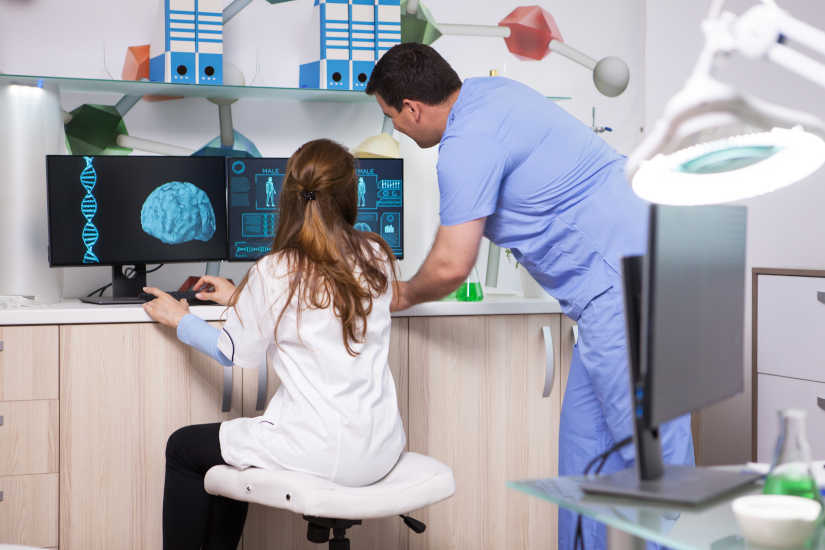
por Luis Daniel Fernádez | Dec 5, 2024 | AI in medicine
The progress of new technologies has enabled a great evolution in the field of medicine. Nowadays, artificial intelligence (AI) has become a fundamental tool in different medical specialties, among which the area of image diagnosis. The integration of AI in medical diagnostics offers a multitude of benefits: increased accuracy and quality of diagnostics, early disease detection, task automation, workflow optimization, creation of personalized treatments and preventive measures.
Obtaining a rapid, accurate and effective diagnosis is a key aspect of achieving more efficient healthcare. The use of traditional methods involves the analysis of a large amount of data and the performance of tasks that involve a large amount of data. investment of time and resources. In addition to these aspects, there is also the limitation of the human subjectivityThe use of algorithms for the diagnosis and treatment of the disease, which can lead to errors in clinical practice. In this sense, the use of Artificial Intelligence in medicine has had a remarkable impact on diagnostic imaging. In the following article, we look at how AI that analyzes medical images works and its main applications.
Artificial Intelligence techniques in the analysis of medical images.
Artificial intelligence studies, designs and develops computerized computer systems based on algorithms. that can emulate some of the functions performed by humans, such as thinking and learning to solve problems. An algorithm consists of a set of computer instructions that are designed to perform a specific task. In recent years, a number of tools have emerged, such as the AI-enabled software that use artificial intelligence to automate many tasks and functions in the clinical setting.
What type of technology is used in medical imaging and how does it work? We can differentiate between different techniques:
Machine Learning (ML)
Machine Learning (ML) is a field of artificial intelligence which consists of the use of computer algorithms to analyze and classify data, to learn from it and to make future predictions. The system must comply with a training phase which is referred to as supervised. During this process, medical images are entered with their corresponding, manually implemented labels. As more data is exposed, the algorithm learns to give a specific answer by evaluating different hand-labeled tests.
Most imaging systems make use of this type of artificial intelligence and it is important that, before using it in clinical practice, the system has been tested and validated. One of its main uses is to predict diseases at an early stage. For example, analyzing the probability that a breast lump visible on mammography is a malignant tumor.
Representational Learning or Representation Learning (RL)
Representation Learning (RL) is a sub-type of Machine Learning (ML) that does not require image features to be labeled by hand. Computer algorithm learns on its own the necessary characteristics to classify the data provided. Therefore, human subjectivity is eliminated, i.e., the limitation of analyzing those characteristics that the human being considers relevant. This system is called unsupervised learning and, if sufficient data is provided, the performance that can be obtained is superior to traditional ML.
Deep Learning (DL)
Deep Learning (DL) is an advanced form of Representation Learning (RL). This type of algorithm is in charge of exploring the use of artificial neural networks.based on the structure and function of the human brain. The artificial network of neurons is composed of different layers and connections. Through each layerIn addition, a series of data is propagated that is linked to the performance of a specific task.
In the area of diagnostic imaging, each layer is responsible for analyzing a characteristic of the medical image and assigning a value to it. Subsequently, the final layers of neurons are responsible for collecting all the information and providing a result. This type of technology has great potential and interest in medical image analysis, as it allows multiple uses. From the automatic detection of a lesion in the images and suggest differential diagnoses to structure a report in a preliminary way.
6 applications of AI in medical image analysis
Artificial Intelligence has the ability to process large amounts of data and recognize complex patterns. We can highlight the following applications in the field of diagnostic imaging:
1. Attendance at the radiologist's work
Power of Attorney manage patients' medical records electronically is a very important step forward, since it facilitates the work of the various medical teams involved in the diagnostic imaging process. AI can help to highlight the most relevant data and propose a specific planning of the study to provide information to the different professionals: the clinician, the technician and the radiologist.
2. Optimization of the radiological technique
Using Deep Learning (DL) methods, the algorithms allow for reconstruct images in medical techniques such as magnetic resonance imaging and computed axial tomography, or TAC. With this, the quality of medical images can be increased, making the most of the technical and physical resources available. Another advantage offered by AI is that it makes it possible to establish the ideal amount of radiation for each patient, avoiding the addition of unnecessary radiation.
3. Segmentation and lesion detection
Through the use of AI, the systems can understand the visualized images of an examination and differentiate healthy structures from pathological areas.
4. Classification and diagnosis of pathologies
There are different machine learning algorithms that can identify specific patterns and characteristics in medical imaging for classify them into different disease categories. Currently, algorithms are being developed for the detection of tumors in mammography images and skin cancer in dermoscopy images. In this field, AI can identify cancerous tissues and classify them into specific cancer types, which can lead to faster and more accurate diagnostics.
5. Prediction of treatment response
Artificial Intelligence can also predict patient response to different treatments. Algorithms can access patient data and medical studies with the diagnosis of the patient's disease. With all this information, the patient's response to various treatment options can be predicted. This offers many advantages, as the following can be developed specific treatment plans with a personalized approachadapted to the needs of each patient.
6. Early detection of diseases
Another of the applications of AI in medicine is the early detection of diseases. Through the analysis of large amounts of data, it is possible to detect patterns that may be missed by traditional techniques. For example, one of the uses recently offered by machine learning algorithms is to be able to detect early changes in magnetic resonance images of the brain, which may be indicative of diseases such as Alzheimer's disease.
Conclusion
The AI-assisted medical diagnosis is evolving rapidly. Ongoing research is currently underway to refine existing AI models with the goal of exploring new applications to provide much more accurate, efficient and faster medical care.
Bibliography
Cuevas Editores (s. f.).
Imaging: Volume 5 (p. 22). Retrieved from
https://cuevaseditores.com/libros/diciembre/imagenologiavol5.pdf#page=22
Durán, L., & Gutiérrez, M. (2020). Imaging: Technical fundamentals and medical application. Vitalia, 8(2), 183-278. Retrieved from https://revistavitalia.org/index.php/vitalia/article/view/183/278
Radiological Society of Uruguay (2021). Radiology and technological innovation in Latin America. Journal of Diagnostic Imaging, 4(1), 53-63. Retrieved from https://www.sriuy.org.uy/ojs/index.php/Rdi/article/view/53/63
Radiological Society of Uruguay (2022). New trends in diagnostic radiology. Journal of Diagnostic Imaging, 5(2). Retrieved from https://www.sriuy.org.uy/ojs/index.php/Rdi/article/view/94
Fernández, J., & Salazar, A. (2023). Advances in medical imaging techniques. Latin Science, 7(3), Article 13751. Retrieved from https://www.ciencialatina.org/index.php/cienciala/article/view/13751
Luis Daniel Fernandez Perez
Director of Diagximag. Distributor of medical imaging equipment and solutions.


por Luis Daniel Fernádez | Nov 25, 2024 | Equipment analysis
Technology is becoming increasingly important when it comes to storing and managing different data and resources. In the field of medicine, we can highlight the RIS management system for diagnostic imaging. This is a type of specialized software used in the radiology area and in other medical fields to manage information and processes related to the services provided by the image diagnosis. In the following article, we analyze how it works, its main features and advantages.
What is the RIS management system for diagnostic imaging?
The RIS management system is responsible for automating the management of medical imaging data and information. It works like a hospital information system (HIS), but the main difference is that it is specifically tailored to radiology departments in clinics, hospitals and healthcare centers.
It is called RIS (Radiology Information System) and represents a key part of the IT infrastructure in radiology departments, clinics and hospitals. A radiodiagnostic software is a tool that includes a multitude of functions in a single centralized platformfrom manage patient data and history, store medical images and create customized reports. Therefore, it stands out as a solution that helps to improve workflows and optimize medical imaging processes.
Main features and functions of the RIS system
How does the RIS system work? We analyze the main features and functionalities it offers:
Patient registration
Firstly, the RIS system is used to register the patients to be attended. For this purpose, the different data to create your medical record: the personal information of contact, the medical history and the insurance information.
Appointment scheduling
Once the patients are registered in the system, they can be scheduling appointments for diagnostic imaging tests. From radiographs, computed tomography or CAT scans, magnetic resonancesetc. The software organizes and prioritizes orders according to urgency, equipment and personnel availabilityoptimizing the management of time and available resources.
Storage and tracking of medical images
Radiologists can attach the results of the images generated after the medical tests directly to the patient's fileThis speeds up the availability of the studies. At the same time, it also allows include data related to medical examinationssuch as reports and diagnostic information.
Patient follow-up and test management
The RIS system makes it possible to perform the follow-up of the patient's treatment and of the examinations carried out through the system. In this way, the complete medical history can be accessed and patient information can be checked for necessary updates during the diagnostic process.
Workflow tracking
Allows you to track each stage of the process, from the initial request to the generation of the final reportThe system ensures efficient and uninterrupted execution. Another aspect to highlight is that improves collaboration between different medical teams who work in patient treatment, such as radiologists, technicians and medical specialists.
Report generation
Radiologists can writing and sharing diagnostic reports based on processed images. The reports are securely stored and made available to physicians and also to authorized patients. The results are generated digitally, but can also be sent by e-mail and fax, as well as exported for printing on paper. Using the RIS system, different statistical reports can be produced, either for specific examinations, individual patients or groups of patients.
Data analysis and statistics
The system produces reports and statistics on workflows, volumes of studies performed and equipment performanceThe results of this study will facilitate administrative decision making and increase the efficiency of diagnostic imaging services.
Data storage and security
All information, including images, reports, and financial records, is stored in secure databases. This helps to ensure the compliance with medical and privacy regulationssuch as GDPR in Europe or HIPAA in the United States.
Billing and administration
Another of its functions is that automates the creation of invoices related to exams performed. By integrating payment and insurance records, financial management processes can be simplified.
What are the advantages of RIS for diagnostic imaging?
The RIS management system offers numerous advantages, mainly in terms of efficiency, accuracy and quality of service in the field of radiology. We explain its main benefits in the medical field:
Workflow optimization
Allows you to manage all stages of medical diagnosisfrom the request to the delivery of reports. This helps to improve organization and reduce delays that may arise. At the same time, automated appointment scheduling ensures that the efficient use of time and resources.
2. Accuracy and security of data
Reduces the occurrence of errors by centralizing patient information, as test results are located on a single platform. On the other hand, by complying with data security regulations such as HIPAA and GDPR, the medical information included in the RIS system is kept confidential.The patient's data is processed correctly.
3. Quick access to information
Physicians, radiologists and technicians have immediate access to patient records and studiesThis streamlines clinical decision making. And not only that, the system usually includes a integration with cloud-based solutions. In this way, the medical team can remotely access information from anywhere, anytime.
4. Integration with other medical systems
It works in conjunction with other medical systems: both PACS and HIS. On the one hand, the PACS system is used to manage the long-term storage of both images and patient information, and HIS systems are hospital information software used in the management of clinics and hospitals. Therefore, the integration of these systems into the RIS system makes it possible to create a complete healthcare ecosystem.
5. Improved patient care
Offers a agile, comprehensive and seamless patient care experience. Among its advantages is the reduction of waiting times in treatment planning and diagnosis, the results are available more quickly and reduce the administrative burden to be carried out by professionals and patients.
6. Cost reduction
In addition to optimizing the work process, helps reduce costs and increase profitability. It eliminates the need to create paper documentation and reduces administrative errors, thus optimizing billing processes and scheduling of medical services.
Conclusion
The RIS management system is an essential tool for optimizing administrative and clinical processes in radiology and other areas of diagnostic imaging. The use of radiodiagnostic software helps to increase efficiency, service quality and patient care.
Luis Daniel Fernandez Perez
Director of Diagximag. Distributor of medical imaging equipment and solutions.





